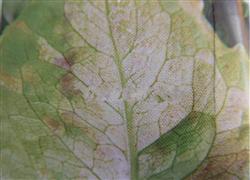Symptoms and Control techniques of Botrytis cinerea in lettuce

A reader in Jiangsu asked, what are the symptoms and control methods of lettuce gray mold? Answer: Botrytis cinerea of lettuce mainly harms leaves and stems and can be infected from seedling stage to adult stage. Get sick at the seedling stage. The leaves and young stems rotted in the form of water immersion, and the diseased part was covered with gray mildew layer. The leaves are infected. Starting from the mature leaves near the ground, the disease initially produces water-immersed spots, which are grayish brown irregular after enlargement. In case of continuous overcast and rainy fields with high humidity, the disease part expands rapidly and spreads to the internal leaves. When the humidity is high, a thick layer of gray mold is produced, that is, the conidiophores and conidia of the pathogen. The stem is infected. Water-immersed spots were produced at the base of the initial stem, which enlarged around the stem, and a thick gray mildew layer was produced when the field humidity was high, which caused the aboveground stems and leaves to wither and the diseased plants gradually withered and died. Control measures (1) crop rotation. Promote 2-3 year rotation with non-Compositae vegetables or Gramineae crops. (2) thick and thin ground preparation. Apply fully mature organic fertilizer, apply sufficient base fertilizer, cultivate in deep ditch and high border, and often clean up the gully system to prevent diseases caused by stagnant water after rain. (3) strengthen cultivation management. Suitable time for sowing, planting, reasonable close planting, greenhouse cultivation pay attention to ventilation, and pay attention to regulating the microclimate in the greenhouse, mainly ecological disease prevention, so as to make the plant grow strong and improve the ability of disease resistance. (4) to clean up the countryside. The disease can be alleviated by removing the remains of diseased plants in time after harvest and taking them out of the field for deep burial or burning. At the same time, dig deep into the soil to accelerate the decay and decomposition of the diseased body. (5) Chemical control. Start spraying at the initial stage of the disease, spray once every 7-10 days, and spray 2-3 times continuously. The medicament can be selected as 80-1000 times (75-100g / mu), 1000-fold (100125g / mu), 1000-fold (100g / mu) and so on.
- Prev

Key techniques of lettuce cultivation in open field
1. Symptoms of the disease: both seedlings and adult plants can suffer from the disease, and the damage to the adult plant is heavy, mainly harming the leaves. The diseased leaf spreads upward from the lower part of the plant, and at first there is a yellowish near-circular polygonal spot on the leaf. When it is wet, the disease spot on the back of the leaf grows white mold, that is, the cyst peduncle and sporangium of the pathogen, sometimes spreading to the front of the leaf, and later.
- Next

Control techniques of Brown spot and Black spot of lettuce
Lettuce brown spot and black spot are considered to be mainly harmful to leaves. The leaf spot of brown spot shows two symptoms: one is water-stained at first, then gradually enlarged into round or irregular shape, brown to dark gray spot, ranging from 2mm to 10mm in diameter. Another kind is dark brown disease spot, the edge is irregular, the periphery has the water stain shape halo. Tide.
Related
- Where is it suitable to grow horseradish in China? it is expected to see the middle altitude horseradish in Alishan.
- How to prevent tomato virus disease reasonably? (Control methods included)
- Many people like to plant towel gourd on the balcony. What are the main points of this method and management?
- What crops can chili peppers be mixed with?
- Fertilization techniques and matters needing attention in Tomato
- What are the grafting techniques for peach seedlings in spring?
- Harm and control methods of root swelling disease of Chinese cabbage
- What are the pests of sweet potatoes? How to prevent and cure it?
- Symptoms, causes and Control methods of navel Rot in Tomato
- The cause of "Cucumber rotten bibcock" in Farmers' planting Cucumber and its Control Plan

